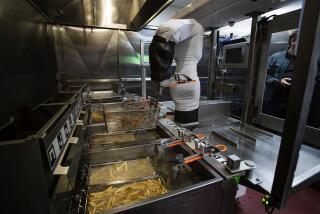Technology Redefines Work Roles
- Share via
When Jane Traut began teaching elementary school 22 years ago, one computer would have taken up an entire classroom and had about as much relevance to her youngsters as a college calculus textbook.
When Elaine Goldner landed her first secretarial job, Liquid Paper was not on the market yet and high tech finally came along in the form of self-correcting electric typewriters.
And when Mary Hargrove-Fox got her start in the banking business, she had to manually record customers’ deposits and withdrawals on a ledger card.
It’s not that any of these women are as old as the hills. It’s just that the technology revolution of the last decade has redefined their careers in ways they never anticipated. And technology is continuing to change the way those entering the work force must approach the teaching, secretarial and banking fields.
“Communication skills and the old-fashioned work ethic are still important,” said Jerry Houser, director of career development at USC. But employers are increasingly requiring new hires to be proficient with computers and other forms of technology, he said.
That should come as no surprise to most office workers. In less than a decade, computers have gone from being a luxury to a necessity. They have forever changed the job market, eliminating some positions, redefining and creating others. Just look at the impact one simple technological development--the automated teller machine--has had on the banking industry.
“When ATMs were introduced in the early 1980s, they really didn’t take off in popularity,” said Sharon Corbitt, a spokeswoman for the American Banking Assn. in Washington. “On the other hand, predictions that eventually there would be no bank tellers didn’t materialize, either.”
But ATMs have eliminated jobs. In 1985, there were 484,000 bank tellers nationwide, according to the association. By 1994, that had dropped to 441,000, a nearly 9% decrease.
“Before the advent of ATMs, you might have had 10 tellers in the bank to man peak hours,” Corbitt said. “The branch may now be able to get by with five or six.”
Rather than mourn the loss of jobs, however, many in the banking industry applaud the technology.
“Banking is much more exciting because the state of the art keeps expanding,” said Hargrove-Fox, branch sales manager at the American Savings Bank in Lakewood. “I’m constantly learning; it’s a constant challenge. It’s much easier to interact with your customers, because you have more time. You’re not spending your time looking for ledger cards.”
As Hargrove-Fox notes, being a teller in today’s market requires more than just clerical skills. More than likely, today’s teller will also be sitting at a customer service desk, advising customers about the latest in interest rate changes, IRA accounts or personal loans.
“Tellers are interchangeable in several spots in the bank,” Corbitt said.
Computers are having a similar effect in the secretarial field, where in many cases clerical work has been taken over by executives who now find it is just as easy to type their own memos or letters as it is to dictate them to someone who can take shorthand.
“What the computer has done is reinforce trends that were already happening,” said Ellen Bravo, executive director of 9 to 5 in Milwaukee. “Clerical functions are automated, you have spell check, a lot more managers are doing their own reports. The turnout [of work] is much greater.”
As a consequence, being a secretary these days is likely to mean more responsibility.
“It’s not unreasonable to find two attorneys sharing one secretary because the computer does so much more of the work,” said Goldner, a secretary assistant with the law firm Morrow, Scuria, Golenor & Salisbury in Westlake Village. “But now, quite often, the legal secretary is also a legal assistant or a paralegal.”
With increased responsibility, Goldner said, comes a need for different skills.
“Typing skills had to be at a premium when I first started out,” she said. But now vocabulary skills are more important, along with the ability to use computers to prepare documents.
Like bankers and secretaries, teachers are adapting to new technology, often including TVs, VCRs, laser discs, CD-ROMs, digitizers, scanners, modems and the Internet.
“There has been a major transition for the computer from being a computational device to an informational retrieval means,” said Ogden Forbes, a researcher at Pepperdine University who specializes in the Internet. “In the area of teaching, [modems] give both teachers and students a great deal of flexibility in terms of when they meet and how they meet.
“Some of the finest professors can be in New York and students can access them from all over the planet,” Forbes said.
*
Although some critics complain that money spent on technology would be better used on books, computers are making their inexorable way into schools across the country, challenging teachers to find creative ways to incorporate the technology.
“The biggest issue with technology is how you use it,” said Michele Parga, technology coordinator for Los Angeles Learning Centers, a private corporation that serves the Los Angeles Unified School District. “The curriculum is still driving the class.
“We don’t teach technology,” Parga said. “We teach from a curricular standpoint and show how technology is a tool.”
U.S. schools have an average of one computer for every 11 students, according to Richard Simpson, assistant superintendent of instructional services for the Conejo Valley School District in Thousand Oaks. He said his district is fairly representative of the national average.
One of the primary challenges for teachers is getting the training they need to integrate computers into the daily rhythm of classroom life.
“There is a tremendous amount of staff development that is needed and will be needed in the future to improve student learning or improve the teacher’s ability to deliver that instruction,” Simpson said.
Traut, a kindergarten teacher at Park Oaks Elementary School in Thousand Oaks, is one educator determined to bring the very youngest students into the 21st century. She has one modern-day computer and three geriatric models, including one she brought from home, in her classroom.
“My goal,” she said, “is to have the computers going all of the time.”
More to Read
Inside the business of entertainment
The Wide Shot brings you news, analysis and insights on everything from streaming wars to production — and what it all means for the future.
You may occasionally receive promotional content from the Los Angeles Times.










